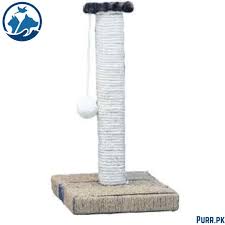If you’ve ever watched your cat methodically shred your expensive sofa while completely ignoring the cat scratching post you bought specifically to prevent this exact scenario, you’re not alone. The relationship between cats and scratching posts can be surprisingly complex, but understanding what makes a scratching post actually appealing to your feline friend can transform your home from a war zone back into a peaceful coexistence.
Why Cats Scratch (And Why They Can’t Just Stop)
Scratching isn’t your cat being vindictive or trying to destroy your belongings out of spite. It’s actually a complex behavior that serves multiple important purposes. When cats scratch, they’re maintaining their claws by removing the outer sheaths, marking their territory through scent glands in their paws, stretching their muscles, and expressing emotions like excitement or stress.
The territorial marking aspect is particularly important to understand. Your cat isn’t just randomly scratching things – they’re deliberately marking areas that are significant to them. This is why they often target furniture in high-traffic areas or items that smell strongly of their favorite humans.
This natural behavior is so deeply ingrained that declawing a cat doesn’t eliminate the urge to scratch – it just removes their ability to do it effectively. The solution isn’t trying to stop the behavior but redirecting it to appropriate outlets.
Types of Scratching Posts and What Works Best
Traditional Vertical Posts These tall, sturdy posts allow cats to stretch fully while scratching, which is crucial for proper muscle extension. The height should allow your cat to reach up without their back feet leaving the ground. Most cats prefer posts that are at least 30 inches tall, though larger cats may need even taller options.
The base needs to be heavy and stable enough that the post won’t wobble or tip when your cat puts their full weight against it. A wobbly post will quickly teach your cat to avoid it entirely, sending them back to your furniture.
Horizontal Scratching Pads Some cats prefer to scratch horizontally rather than vertically. These low-profile options work well for cats with arthritis or mobility issues, and many cats enjoy having both horizontal and vertical options available.
Cardboard scratching pads are popular horizontal options because they’re inexpensive and many cats love the texture. The downside is that they create mess as cats scratch, shedding cardboard bits around your home.
Angled Scratching Surfaces These compromise between vertical and horizontal, offering a slanted surface that some cats find more comfortable than pure vertical scratching. They’re particularly good for older cats who might struggle with the full stretch required for tall vertical posts.
Multi-Level Cat Trees These combine scratching surfaces with climbing opportunities, perches, and sometimes hiding spots. They’re space-efficient and can satisfy multiple feline needs in one piece of furniture. The key is ensuring the scratching surfaces are large enough and positioned at angles your cat actually wants to use.
Material Matters More Than You Think
Sisal Rope and Fabric Sisal is the gold standard for scratching post materials because it provides excellent resistance and a satisfying texture for most cats. Sisal rope wrapped around a post creates vertical lines that many cats prefer, while sisal fabric offers a different texture experience.
The quality of sisal varies significantly. Cheap, loosely woven sisal won’t last long and may not provide the resistance cats need for effective scratching. High-quality sisal should be tightly woven and securely attached to the post structure.
Carpet While many scratching posts feature carpet, it’s actually not ideal for most cats. Carpet can catch claws uncomfortably, and using carpet on scratching posts can confuse cats about which carpeted surfaces are appropriate for scratching.
If you do choose carpet-covered posts, ensure the carpet is tightly attached and won’t come loose with use. Loose carpet can be both frustrating for cats and potentially dangerous if they ingest pieces.
Corrugated Cardboard Many cats absolutely love the texture of corrugated cardboard for scratching. It’s soft enough to be comfortable while still providing resistance. The main drawbacks are the mess it creates and the need for frequent replacement.
High-quality cardboard scratchers are denser and last longer than cheap versions. Some are reversible, effectively doubling their lifespan.
Natural Wood Some cats prefer scratching natural wood, particularly if they have outdoor experience. Wood posts need to be made from appropriate types of wood that won’t splinter dangerously. Cedar and other aromatic woods can be particularly appealing to cats.
Placement Strategy: Location, Location, Location
Where you put a scratching post is just as important as what kind you buy. Cats prefer to scratch in areas where they spend time, not hidden away in unused corners. Consider placing posts near sleeping areas, since many cats like to stretch and scratch when they wake up.
High-traffic areas work well because they allow cats to mark territory in socially significant spaces. If your cat has already been scratching furniture, place the post directly in front of the damaged area initially, then gradually move it to a more convenient location.
Multiple cats need multiple scratching options, and they should be placed throughout your home rather than clustered in one area. Each cat should have access to scratching surfaces in their preferred areas without having to compete with other cats.
Size and Stability Requirements
A wobbly scratching post is worse than no post at all because it teaches cats to avoid it entirely. The base should be heavy enough and wide enough to prevent tipping even when cats put their full weight against it while scratching vigorously.
Height is crucial for vertical posts. Cats need to be able to fully extend their bodies while scratching, which means the post should be tall enough for your cat to stretch upward without their back feet leaving the ground. For most cats, this means a minimum height of 30 inches, though larger breeds may need even taller options.
Width matters too, especially for multi-cat households. A post should be wide enough that cats can scratch comfortably without feeling cramped, and wide enough that multiple cats could potentially use it simultaneously if needed.
Training Your Cat to Use the Post
Simply buying a scratching post doesn’t guarantee your cat will use it. You may need to actively encourage appropriate scratching behavior. Start by making the post appealing – many cats are attracted to catnip, so rubbing the post with catnip or catnip spray can help draw their attention.
Demonstrate the post yourself by running your fingernails along the surface. This sounds silly, but many cats are intrigued by the sound and will investigate. When they do show interest in the post, reward them immediately with praise, treats, or play.
If your cat continues scratching furniture despite having access to appropriate posts, try temporarily covering the furniture with materials that are unpleasant to scratch, like aluminum foil or double-sided tape. This should be temporary while you redirect them to appropriate surfaces.
Maintenance and Replacement
Even the best scratching posts will eventually wear out. Monitor the condition of scratching surfaces and replace them when they become too smooth or worn to be effective. Many cats actually prefer posts that show some wear, as the scent marking from previous scratching makes them more appealing.
For posts with replaceable parts, keep spare components on hand so you can replace worn sections immediately. A gap in available scratching surfaces often leads cats back to furniture.
Clean posts occasionally to remove excess fur and debris, but don’t over-clean them. Cats prefer posts that smell like them, so aggressive cleaning can actually make posts less appealing.
Dealing with Multiple Cats
Multi-cat households face additional challenges with scratching posts. Cats may need to establish hierarchy around preferred scratching locations, and some cats may avoid posts that smell strongly of other cats.
Provide more scratching options than you think you need. A good rule of thumb is one more post than you have cats, distributed throughout your living space. Different cats may prefer different materials or styles, so variety helps ensure everyone’s needs are met.
Watch for signs of competition or stress around scratching posts. If cats seem to avoid posts after other cats use them, you may need additional posts or posts in separate areas where cats can scratch without feeling vulnerable.
Finding the right scratching post for your cat can feel like a puzzle, but understanding your cat’s preferences and providing appropriate options can completely eliminate furniture scratching. LifeGizmoHub offers a comprehensive selection of scratching posts in various materials, sizes, and styles, along with detailed guidance to help you choose options that will actually appeal to your particular cat’s scratching preferences and keep your furniture safe from those determined claws.





